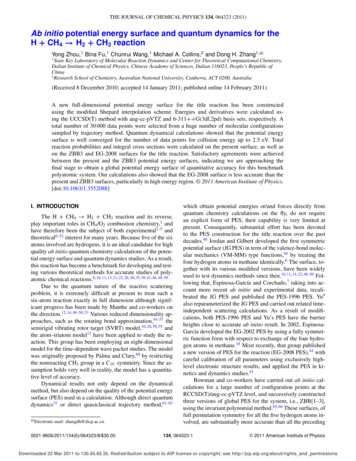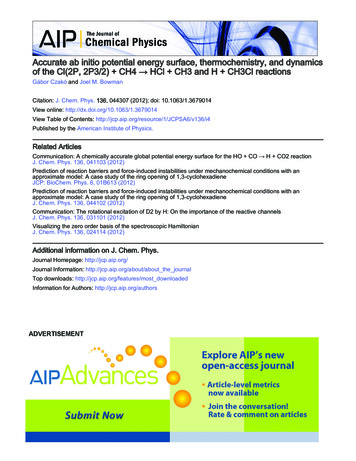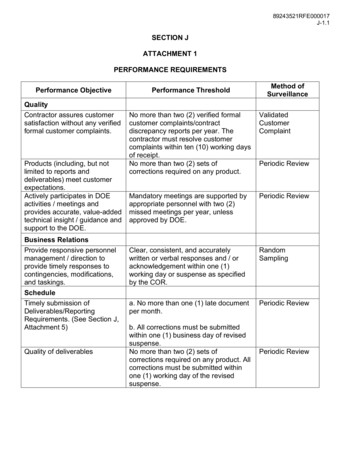
Transcription
THE JOURNAL OF CHEMICAL PHYSICS 134, 064323 (2011)Ab initio potential energy surface and quantum dynamics for theH CH4 H2 CH3 reactionYong Zhou,1 Bina Fu,1 Chunrui Wang,1 Michael A. Collins,2 and Dong H. Zhang1,a)1State Key Laboratory of Molecular Reaction Dynamics and Center for Theoretical Computational Chemistry,Dalian Institute of Chemical Physics, Chinese Academy of Sciences, Dalian 116023, People’s Republic ofChina2Research School of Chemistry, Australian National University, Canberra, ACT 0200, Australia(Received 8 December 2010; accepted 14 January 2011; published online 14 February 2011)A new full-dimensional potential energy surface for the title reaction has been constructedusing the modified Shepard interpolation scheme. Energies and derivatives were calculated using the UCCSD(T) method with aug-cc-pVTZ and 6-311 G(3df,2pd) basis sets, respectively. Atotal number of 30 000 data points were selected from a huge number of molecular configurationssampled by trajectory method. Quantum dynamical calculations showed that the potential energysurface is well converged for the number of data points for collision energy up to 2.5 eV. Totalreaction probabilities and integral cross sections were calculated on the present surface, as well ason the ZBB3 and EG-2008 surfaces for the title reaction. Satisfactory agreements were achievedbetween the present and the ZBB3 potential energy surfaces, indicating we are approaching thefinal stage to obtain a global potential energy surface of quantitative accuracy for this benchmarkpolyatomic system. Our calculations also showed that the EG-2008 surface is less accurate than thepresent and ZBB3 surfaces, particularly in high energy region. 2011 American Institute of Physics.[doi:10.1063/1.3552088]I. INTRODUCTIONThe H CH4 H2 CH3 reaction and its reverse,play important roles in CH4 /O2 combustion chemistry,1 andhave therefore been the subject of both experimental2–5 andtheoretical6–52 interest for many years. Because five of the sixatoms involved are hydrogens, it is an ideal candidate for highquality ab initio quantum chemistry calculations of the potential energy surface and quantum dynamics studies. As a result,this reaction has become a benchmark for developing and testing various theoretical methods for accurate studies of polyatomic chemical reactions.8, 10, 11, 13, 21, 22, 26, 30, 35, 39, 41, 46, 48–50Due to the quantum nature of the reactive scatteringproblem, it is extremely difficult at present to treat such asix-atom reaction exactly in full dimension although significant progress has been made by Manthe and co-workers onthe direction.12, 14, 48–50, 53 Various reduced dimensionality approaches, such as the rotating bond approximation,54–57 thesemirigid vibrating rotor target (SVRT) model,10, 20, 58, 59 andthe atom–triatom model13 have been applied to study the reaction. This group has been employing an eight-dimensionalmodel for the time-dependent wave packet studies. The modelwas originally proposed by Palma and Clary,60 by restrictingthe nonreacting CH3 group in a C3V symmetry. Since the assumption holds very well in reality, the model has a quantitative level of accuracy.Dynamical results not only depend on the dynamicalmethod, but also depend on the quality of the potential energysurface (PES) used in a calculation. Although direct quantumdynamics15 or direct quasiclassical trajectory method,61–63a) Electronic mail: zhangdh@dicp.ac.cn.0021-9606/2011/134(6)/064323/8/ 30.00which obtain potential energies or/and forces directly fromquantum chemistry calculations on the fly, do not requirean explicit form of PES, their capability is very limited atpresent. Consequently, substantial effort has been devotedto the PES construction for the title reaction over the pastdecades.40 Jordan and Gilbert developed the first symmetricpotential surface (JG PES) in term of the valence-bond molecular mechanics (VM-MM) type functions,64 by treating thefour hydrogen atoms in methane identically.6 The surface, together with its various modified versions, have been widelyused to test dynamics methods since then.10, 11, 14, 22, 48–50 Following that, Espinosa-García and Corchado,7 taking into account more recent ab initio and experimental data, recalibrated the JG PES and published the PES-1996 PES. Yu9also reparameterized the JG PES and carried out related timeindependent scattering calculations. As a result of modifications, both PES-1996 PES and Yu’s PES have the barrierheights close to accurate ab initio result. In 2002, EspinosaGarcía developed the EG-2002 PES by using a fully symmetric function form with respect to exchange of the four hydrogen atoms in methane.18 Most recently, that group publisheda new version of PES for the reaction (EG-2008 PES),44 withcareful calibration of all parameters using exclusively highlevel electronic structure results, and applied the PES in kinetics and dynamics studies.45Bowman and co-workers have carried out ab initio calculations for a large number of configuration points at theRCCSD(T)/aug-cc-pVTZ level, and successively constructedthree versions of global PES for the system, i.e., ZBB[1–3],using the invariant polynomial method.65, 66 These surfaces, offull permutation symmetry for all the five hydrogen atoms involved, are substantially more accurate than all the preceding134, 064323-1 2011 American Institute of PhysicsDownloaded 22 Mar 2011 to 130.56.65.35. Redistribution subject to AIP license or copyright; see http://jcp.aip.org/about/rights and permissions
064323-2Zhou et al.J. Chem. Phys. 134, 064323 (2011)surfaces. Quasiclassical trajectory calculations performed onthese surface for the H CH4 and H CD4 reactions produced very interesting results.32, 34, 65, 66The modified Shepard interpolation method, developedby Collins and co-workers,67–70 has been used to constructPESs for the system over the years. Collins and co-workerstested the method on the JG PES first,71 and found thatabout 1000–1300 data points were sufficient to reproduce theJG PES. Later, Manthe and co-workers used the scheme toconstruct a full-dimensional PES based on high level ab initio calculations. Full-dimensional multiconfigurational timedependent Hartree (MCTDH) studies on the PES yieldedthermal rate constants comparable to (or even exceeding)experimental precision for the H CH4 H2 CH3reaction.26, 30, 33 Unfortunately, the PES is limited to the vicinity of abstraction saddle, therefore cannot be used for globaldynamical studies.Recently, we constructed a new ab initio full-dimensionalPES for the system using the modified Shepard interpolation method based on extensive high level of ab initio calculations. Seven-dimensional quantum dynamics calculationscarried out on the PES for the H CD4 HD CD3 reaction produced an integral cross section (ICS) in good agreement with the experimental results,52 and with that obtainedon the ZBB3 PES. Since these two PESs were constructed byusing two totally different methods, the good agreement onthe ICS obtained from these two PESs indicates that PES forthis benchmark six-atom reaction is approaching a quantitative level of accuracy. In this paper, we report in detail theconstruction of the PES, and compare it with the EG-2008PES and ZBB3 PES by carrying out seven-dimensional timedependent wave packet (TDWP) calculations.The paper is structured as follows. In Sec. II we presentthe method used in PES construction as well as that in TDWPcalculation. Results and discussions are showed in Sec. III.The conclusions are given in Sec. IV.II. THEORYXχsCRθ2rϕ2Zϕ1θ1YFIG. 1. The eight-dimensional Jacobi coordinates for the X YCZ3 system.where V [Z(i)] is the value of the potential at Z(i), the derivatives are taken with respect to inverse distances at Z(i).Suppose that the energy and derivatives are calculatedat a number, Nd , of nuclei configurations, total potential energy at any configuration Z is given as a weighted average ofthe Taylor series about all Nd data points and their symmetryequivalents:V (Z) Nd w g i (Z)Tg i (Z),(2)g G i 1wherew i (Z) v i (Z) Nd v g k (Z).g G(3)k 1The normalized weight function, w i , represents how close isthe data point to the configuration Z, and data points nearer toZ will have larger weights than those at large distances. Theun-normalized weight function, v i is defined as 1 Z Z(i) 2q Z Z(i) 2 p ,(4)v i (Z) rad(i)rad(i)where rad(i) plays the role of a confidence radius.69 Note thatin Eq. (3) the summation is taken over the appropriate symmetry group G, which roots in the nature that any permutationperformed onto the six hydrogen atoms will not influence thepotential value. With all subgroups of G taken into consideration, the dataset is symmetrized, thus the PES of Eq. (3)exhibits the full molecular symmetry.A. The PES interpolation schemeIn the modified Shepard interpolation method, interpolation is given by a weighted sum of Taylor polynomials. Foran N -atom reaction system, the nuclei geometry can be defined by 3N 6 (3N 5 for collinear geometry) internal coordinates (inverse distances here). The potential energy at aconfiguration, Z, in the vicinity of a data point Z(i) can beexpanded as a Taylor series Ti : V Ti (Z) V [Z(i)] [Z k Z k (i)] Z k Z Z(i)k 13N 6 2 V ···, Z k Z j Z Z(i)The time-dependent quantum wave packet calculationsused the eight-dimensional (8D) model for the X YCZ3reaction by restricting the nonreacting CZ3 group in a C3Vsymmetry.22, 37, 39, 61 The 8D Hamiltonian in the Jacobi coordinates (R, r, s, χ , θ1 , ϕ1 , θ2 , ϕ2 ) shown in Fig. 1 can bewritten as1 21 2( Jˆtot Jˆ)2lˆ2vibĤ K̂ CZ2μ R R 22μr r 22μ R R 22μr r 2rot K̂ CZ V (R, r, s, χ , θ1 , ϕ1 , θ2 , ϕ2 ),3N 6 3N 61 [Z k Z k (i)]2! k 1 j 1 [Z j Z j (i)]B. The time-dependent wave packet method(1)(5)where μ R is the reduced mass of X and YCZ3 , μr is the reduced mass of Y and CZ3 , R is the distance between X andthe center of mass (COM) of YCZ3 , r is the distance betweenY and the COM of the CZ3 group, s is the bond length ofCZ, χ is the angle between the CZ bond and the C3V symmetry axis, vector s, of the CZ3 group, Jˆtot is the total angularDownloaded 22 Mar 2011 to 130.56.65.35. Redistribution subject to AIP license or copyright; see http://jcp.aip.org/about/rights and permissions
H CH4 potential energy surface and dynamics064323-3J. Chem. Phys. 134, 064323 (2011)momentum operator of the system, Jˆ is the rotational angular momentum operator of YCZ3 , and lˆ is the orbital angularmomentum operator of atom Y with respect to CZ3 . The lastterm V (R, r, s, χ , θ1 , ϕ1 , θ2 , ϕ2 ) is the potential energy.In the present study, we fixed the CH bond length in thenonreacting CH3 group based on the fact that it essentiallydoes not change during the reaction, to reduce the degree offreedom from 8 to 7. As a result, the vibrational kinetic energyoperator in Eq. (5) can simply be given as,22, 37cos2 χ 2sin2 χ μxμs χ 2 1 11sin χ cos χ, 2 s μχμs χvibK̂ CZ 12s 2(6)where μx and μs are related to the mass of atoms C andZ, μx 3m z and μs 3m c m z /(m c 3m z ). The rotationalkinetic energy operators of CZ3 K̂ CrotZ can be written as,rotK̂ CZ1 2ĵ 2IA11 2IC2IAĵz2 ,JK2. The spherical harmonics Y jlk(r̂, ŝ)the eigenfunctions of Jˆtotare given by 2l 1jJKJ jml0 J m D̄mk (ŝ),D̄ K m (r̂ )Y jlk (r̂, ŝ) 2J 1m(12)where D̄ KJ m (r̂) depend on Euler angles which rotate theXYCZ3 body-fixed frame onto the YCZ3 -fixed frame, andjD̄mk (ŝ) depend on Euler angles which rotate the YCZ3 -fixedframe onto the CZ3 -fixed frame.The initial state wave function is constructed as the directproduct of a standard Gaussian functionG 0 (R) (π δ 2 ) 1/4 exp (R R0 )22δ 2exp( ik0 R)(13)and the rovibrational eigenfunction of YCZ3 , ψnJ0totJ0MεK 0 p0 ,which satisfies the following asymptotic HamiltonianĤYCZ3 (7)1 2lˆ2vibrot K̂ CZ K̂ CZ22μr r2μr r 2 V (R , r, χ , θ1 , θ2 , ϕ1 , ϕ2 ).(14)where IA and IC are the rotational inertia of CZ3 , defined asIA 32m cm z s 2 sin2 χ cos2 χ2m c 3m z(8)andIC 3m z s 2 sin2 χ ,(9)ĵ is the rotational angular momentum of CZ3 and Jˆz is itsz-component.The seven-dimensional (7D) time-dependent wave function is expanded in terms of basis functions of R, r , χ , and thebody-fixed (BF) total angular momentum eigenfunctions as Jtot Mε n,vr ,v χ K Jl jkJtot M K εCnv(t) Fnvr (R)φvr (r )φvχ (χ )r v χ Jl jkJtot M K ε( R̂, r̂ , ŝ),Jl jk Pi (E) Im ψi E ψi E r rs ,μrwhere ψi E 1ai (E) ei(E H )t/ i (0) dt,(15)(16)0with ai (E) φi E i (0) being the overlap between the initial wave packet i (0) and the energy-normalized asymptoticscattering function φi E .III. RESULTS(10)where n, vr , and v χ are labels for the basis functions in R, r ,and χ coordinates, respectively, Fnvr are sine basis functionsfor R which are dependent on vr for their spatial ranges to separate interaction region from asymptotic region,72 and φvr (r )and φvχ (χ ) are basis functions for r and χ , respectively.The BF total angular momentum basis functionsJtot M K ε( R̂, r̂ , ŝ) are defined asJl jkJtot M K ε( R̂, r̂ , ŝ)Jl jkThe wave function is propagated using the split-operatormethod and the total reaction probabilities for a specific initialstate are calculated from the time-independent wave functionat a dividing surface r rs , Jtot1JKD̄ ( R̂)Y jlk(r̂ , ŝ)2(1 δ K̄ 0 δk0 ) M K JtotJ K ε( 1) Jtot J l j k D̄ M K( R̂)Y jl k(r̂ , ŝ) ,(11)Jtotwhere ε is the parity of the system and D̄ MK ( R̂) are theWigner rotation matrices with three Euler angles which rotate the space-fixed frame onto the body-fixed frame37 and areWe used the unrestricted coupled cluster method withsingle and double excitations including a perturbative treatment of the triple excitations [UCCSD(T)] for the ab initiocalculations, since it has been showed that a single-referencecalculation is sufficient to describe the electronic correlationfor the system.33 As we did for the OH3 system,73 the gradients and Hessians for all the data points were calculated usingthe 6-311 G(3df,2pd) basis sets, while the energies werecalculated with the aug-cc-pVTZ basis set to improve the accuracy of the PES. The sampled configurations were obtainedfrom the paths of classical trajectories in the usual way.71Quantum wave packet calculations were carried out repeatedly to check the convergence of PES with respect to thenumber of data points as shown in Fig. 2. It can be seen that adataset with 5000 points is sufficient to converge the total reaction probability in the low collision energy region, partiallydue to the fact that our “growing” procedure started by sampling the region near the minimum energy path. However, toachieve a good convergence on the total reaction probabilityDownloaded 22 Mar 2011 to 130.56.65.35. Redistribution subject to AIP license or copyright; see http://jcp.aip.org/about/rights and permissions
064323-4Zhou et al.J. Chem. Phys. 134, 064323 0300000.0020.00100.511.522.5Collision Energy (eV)FIG. 2. Convergence of PES with respect to the number of data points forthe total angular momentum Jtotal 0.for the collision energy up to 2.5 eV, one needs to use 30 000data points to construct the PES. This number is much largerthan the one once predicted by Collins and co-workers of theorder of 1000,71 mainly because we use quantum dynamicalmethod instead of quasiclassical trajectory method (QCT) togauge the convergence. In fact, the maximum error for all thereaction probabilities shown in Fig. 2 is about 10%, which iscomparable to the statistical error in most QCT calculations.The energy and geometry of the saddle point are given inTable I, in comparison with the corresponding values obtainedfrom some PESs published recently. The barrier heights forthese PESs all agree rather well. It is 15.03 kcal/mol forthe present PES, very close to the result predicted by theCCSD(T)/aug-cc-pvqz calculation of 14.87 kcal/mol.33 Thisdifference may lead to a relative error of 24% in thermal rateconstant at the room temperature, estimated by the Arrhenius formula. For the geometry of saddle point, the presentPES gives nearly the same structure as the ZBB3 PES andthe Wu’s PES. But some small differences exist betweenthe present PES and the EG-2008 PES, in particular for theumbrella H–C–H angle of the methane molecule. Table IIlists the harmonic frequencies of the reactant, saddle point,and products for those PESs. In general, the agreement is verygood.Table III lists the eigenenergies of the lowest five initialbound states for the zero angular momentum of CH4 withthe nonreacting CH3 group restricted on the C3V geometry(four dimension with CH bond length fixed) calculated on theEG-2008, ZBB3, and the present PES. The state assignmentlabels (v u ,v b ,v s ) represent, respectively, the umbrella excitation of the CH3 group, the bending excitation of the reactiveCH bond, and the stretching excitation of the reactive CHbond. We can see that all of the three PESs give results ingood agreement with each other with the maximum of discrepancies of 0.01 eV, indicating these three PESs describethe asymptotic reaction region equally well.The time-dependent wave packet calculations were carried out on the ZBB3, EG-2008, and the present PES, tocompare these PESs beyond the stationary properties. AnL-shaped wave function expansion for R and r was used toreduce the size of the basis set.72 A total number of 100 sinebasis functions in the range of [3.0, 15.0]a0 were used fortranslational coordinate R including 30 for the interaction region. For the reactive CH bond(r ), 5 and 40 vibrational basisfunctions in the range of [1.0, 5.0]a0 were used for the asymptotic and interaction regions, respectively. The CH bondlength in the nonreacting CH3 group was frozen at 2.06 a0based on the fact that it essentially does not change duringthe reaction. For the umbrella motion, 5 basis functions wereused. The size of rotational basis functions is controlled by theparameters, Jmax 53, lmax 35, jmax 18, and kmax 18,corresponding, respectively, to the rotational angular momentum of CH4 , the orbital angular momentum of HY with respect to the CH3 group, and the rotational angular momentumof CH3 and its z-component. The size of the rotational basisfunctions is 44 460 and the number of grid points for the integration of the rotational basis set is 493 506, with parity andC3V symmetry of the nonreacting CH3 group considered.Figure 3 shows the total reaction probabilities for the totalangular momentum Jtotal 0 on the ZBB3, EG-2008, and ournew PES, together with that obtained earlier on the JG PES.6Note that since the basis set used here is slightly larger thanthat used in potential convergence check, one may notice thattotal reaction probability shown in Fig. 3 differs slightly fromthat shown in Fig. 2. It can be seen that the reaction thresholdfor the present PES agrees very well with that for the ZBB3PES of about 0.4 eV, but is about 0.02 eV lower than that forthe EG-2008 PES, in according with the fact that the barrierTABLE I. Comparison of CH5 saddle point geometries and energies.Energye (kcal/mol)RCH (Å)RCH (Å)RH H (Å)H C H ( )C H H ( )Zhang et al.a14.81.08611.39650.8988102.80180.0Wu et al.b14.931.0851.4010.895103.1180.0Corchado et 1.0851.3990.895103.11180.0aRCCSD(T)/aug-cc-pVTZ (Ref. 32).CCSD(T)/scaled-cc-pVTZ (Ref. 33).cCCSD(T)/cc-pVTZ (Ref. 44).dUCCSD(T)/aug-cc-pVTZ.eRelative to the energy of H CH4 .bDownloaded 22 Mar 2011 to 130.56.65.35. Redistribution subject to AIP license or copyright; see http://jcp.aip.org/about/rights and permissions
H CH4 potential energy surface and dynamics064323-5J. Chem. Phys. 134, 064323 (2011)TABLE II. Comparison of normal mode frequencies (cm 1 ).CH4 HCH5 32233223Zhang et 9Wu et 3Corchado et 3CH3 H2PresentZhang et al.aWu et al.bCorchado et al.cPresentZhang et al.aCorchado et Z (Ref. 32).CCSD(T)/scaled-cc-pVTZ (Ref. 33).cCCSD(T)/cc-pVTZ (Ref. 44).dThis subrow related to the H2 product.bTABLE III. Comparison of eigenvalue of the initial bound states fromthree different PESs. All energy values in eV. See text for the definition of(v u , v b , v s ) used in the state assignment.present PES agree rather well in the entire collision energyrange considered, despite the fact that ICSs from these twoPESs agreed even better for the H CD4 HD CD3reaction.52 The ICS from EG-2008 PES is quite close to thepresent one in the low collision energy region, but is considerably higher in the high collision energy region. From Figs. 3and 4, one can see that the accuracy of the potential energysurface is converging for this benchmark polyatomic system,but some differences still exist among these PESs.The ZBB3 PES was constructed based on about 20 000ab initio data points,32, 34 and the present PES contains 30 000data points, so there are in total 50 000 ab initio data pointsavailable for the reaction system. All these data points hadbeen chosen carefully to sample the molecular configurationwell, so that they can be used as a good dataset to check theglobal accuracy of a PES. In Fig. 5, we show the distributionsof potential energy error (the energy difference between thepotential value from a PES and the ab initio value for a configuration) for the EG-2008, ZBB3, and the present PES. The0.008PresentZZB3EG 2008JG (x0.2)0.006Probabilityheight of EG-2008 PES is 0.013 eV higher than that of ZBB3PES as listed in Table I.Overall, the agreement between the present PES and theZBB3 PES on the total reaction probability is satisfactory.Both PESs give very small reaction probability in the energy range studied, with the maximum of about 0.4%. Abovethe threshold, the total reaction probabilities obtained on bothPESs first increase quickly with the collision energy, then decline with further increase of collision energy, similar to theH CD4 reaction.52 Nevertheless, as one can see from thefigure that the peak positions for the total reaction probabilities differ a little bit, and ZBB3 probabilities decrease slightlyfaster in high collision energy region than the present one. TheEG-2008 reaction probability in low energy region is quiteclose to those from the ZBB3 and present PES. However, forcollision energy higher than 0.7 eV, the EG-2008 PES givesa substantially larger probability. Finally, one can see thatthe JG probability is much larger than those obtained fromthe other three PESs (note the JG probability was dividedby a factor of 5 before plotting). This clearly reveals that theJG PES is qualitatively inaccurate for the system despite thefact that it had been widely used for the developments of newtheoretical methods for polyatomic reactions.10, 11, 14, 22, 48–50Figure 4 shows the ICSs for the title reaction obtainedon three PESs by using the centrifugal sudden (CS) approximation. As expected, the ICSs from the ZBB3 PES and Present0.4550.6220.7860.8080.827Assignment(v u , v b , v s 1.41.6Collision Energy (eV)FIG. 3. Total reaction probabilities on the JG, ZBB3, EG-2008, and presentPES for the total angular momentum Jtotal 0.Downloaded 22 Mar 2011 to 130.56.65.35. Redistribution subject to AIP license or copyright; see http://jcp.aip.org/about/rights and permissions
064323-6Zhou et al.J. Chem. Phys. 134, 064323 (2011)Integral Cross section (a02)0.8PresentZBB3EG 20080.60.40.200.511.5Translational Energy (eV)FIG. 4. Integral cross sections for the H CH4 H2 CH3 reactionobtained on the ZBB3, EG-2008, and present PES.error distributions in Figs. 5(a)–5(c) were obtained by usingthe 30 000 data points calculated in this work. For the presentPES, a data point was removed from the dataset when the error on that data point was calculated. The error distribution inFig. 5(d) was obtained by using the 20 000 data points for theZBB3 PES. It can be seen that the EG-2008 PES has an errordistribution with a width substantially larger than that of the6(a) EG 2008 PES42020(b) ZBB3 PESPercentage (%)1510504030(c) Present PES2010040(d) Present PES/30ZBB3 data20100 0.3 0.2 0.10.00.10.20.3Energy Error (eV)FIG. 5. Distributions of potential energy errors: (a–c) obtained by using the30 000 data points calculated in this work; (d) obtained by using the 20 000data points for the ZBB3 PES.FIG. 6. Distributions of potential energy errors for the 30 000 data pointscalculated in this work on the EG-2008, ZBB3, and present PES, accordingto their ab initio values.other two, while the present PES has a width slightly smallerthan that of the ZBB3 PES. The percentages of data pointswith error smaller than 0.05 eV are 48%, 74%, 91%, and 88%for Figs. 5(a)–5(d), respectively. Thus it is quite reasonable tosay that in general the EG-2008 PES is less accurate than theother two PESs, and the present PES is slightly more accuratethan the ZBB3 PES.Figure 6 shows the distributions of energy errors calculated for these 30 000 data points on the EG-2008, ZBB3, andpresent PES, according to their ab initio potential values. Itcan be seen that both the ZBB3 PES and EG-2008 PES describe the low energy region substantially better than the highenergy region. In contrast, the present PES describes the entire energy region more equally well.The EG-2008 PES was constructed by only samplingthe configuration space with energy slightly above the barrierheight,74 so that it can predict the thermal rate constant quitewell.45 Although the VM-MM model is able to extrapolatereasonably the potential energy for the region not covered infitting, the accuracy is very limited. In contrast, the data pointsused to construct the ZBB3 PES and the present PES samplea much wider energy range as shown in Fig. 7. As a result,these two PESs are more accurate than the EG-2008 PES, inparticular in high energy region. From Fig. 7, one also cansee that the present PES has substantially more data points inthe energy range of [0.8, 2.5] eV, indicating the present PESshould be more reliable than the ZBB3 PES in that energyregion.Downloaded 22 Mar 2011 to 130.56.65.35. Redistribution subject to AIP license or copyright; see http://jcp.aip.org/about/rights and permissions
064323-7H CH4 potential energy surface and dynamics4000(a) ZBB3 PES3000Number of data points200010000(b) Present PES30002000100000123Potential Energy (eV)FIG. 7. Distributions of data points in energy domain for the ZBB3 andpresent PES.However, it is worthwhile to point out that the ZBB3PES is much faster than the present PES on evaluating thepotential value for a given molecular configuration. In fact,the evaluations of potential values on a huge number of gridpoints used in seven- or eight-dimensional quantum wavepacket calculations, rather than the ab initio calculations forall the data points, have substantially hindered the construction of the present PES. The ab initio calculations took about600 days on a workstation with 8 CPU cores in total, whilethe evaluations of the potential values on all the grids for thetitle reaction took about 400 days despite the fact that we havedeveloped many techniques to accelerate the evaluation speed(not like the ab initio calculation, the evaluation should berepeated for different grid sets). In contrast, it only took afew days to carry out the same evaluation for the ZBB3 PES.Obviously, more work should be done to speed up the evaluation further in order to make the PES more useful for QCT orquantum dynamics calculations.IV. CONCLUSIONSA full-dimensional global potential energy surface hasbeen constructed for the title reaction by using the modified Shepard interpolation method. The first and second order derivatives for the data points were calculated at theUCCSD(T)/6-311 G(3df,2pd) level, while the energieswere calculated at the UCCSD(T)/aug-cc-pVTZ level to improve the accuracy of the PES. Quantum wave packet calculations were used to gauge the convergence of the PES withrespect to the number of data points. A total number of 30 000nuclei configurations were selected as the final dataset forthe PES, out of a huge number of configurations sampled bytrajectories.Seven-dimensional time-dependent wave packet calculations were carried out on the EG-2008, ZBB3, and presentPES. Satisfactory agreements were achieved between theJ. Chem. Phys. 134, 064323 (2011)ZBB3 and the present PES on the total reaction probabilities and integral cross sections for the collision energy up to2.5 eV. The results on the EG-2008 PES agree reasonably withthose from the other PESs in the low collision energy region,but substantially larger than the other two PESs in high collision energy region. Because the ZBB3 PES and the presentPES were constructed using two totally different approaches,the satisfactory agreements on the ICS for the title reactionas well as for the H CD4 HD CD3 reaction52 onthese two PESs indicate that we are approaching to the final stage for a quantitatively accurate PES for the benchmarkpolyatomic reaction.Quantum dynamical calculations also showed that somedifferences still exist between the ZBB3 and the present PES.Detailed examinations of the three PESs by using the ab initiodata points obtained in this work and in the work of the ZBB3PES revealed that the present PES is slightly more accuratetha
used to test dynamics methods since then.10 ,11 14 22 48-50 Fol-lowing that, Espinosa-García and Corchado,7 taking into ac-count more recent ab initio and experimental data, recali-brated the JG PES and published the PES-1996 PES. Yu9 also reparameterized the JG PES and carried out related time-independent scattering calculations. As a .










